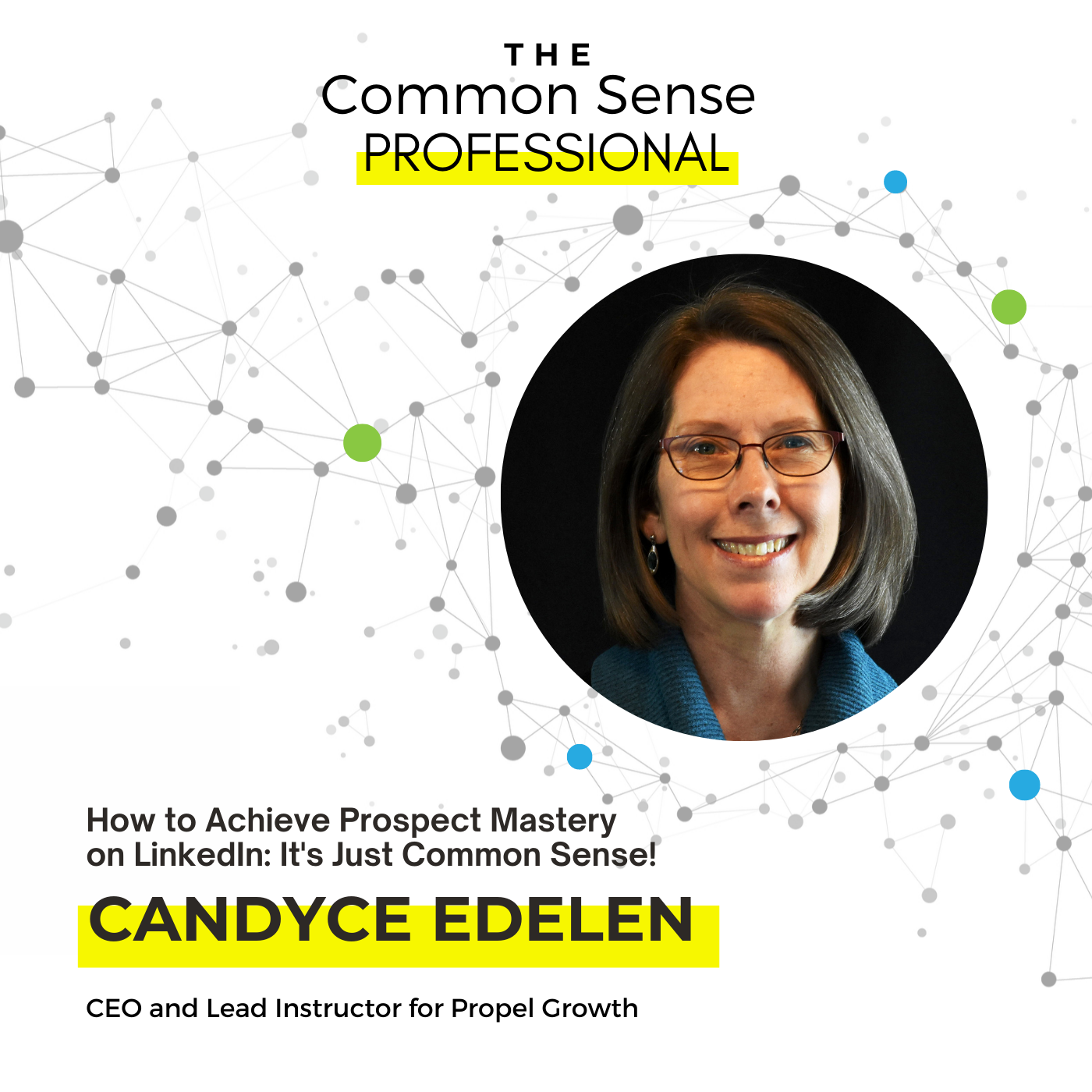
Podcast
How to Achieve Prospect Mastery on LinkedIn: It’s Just Common Sense!
Welcome to the show Candyce Edelen!
Candyce Edelen is a seasoned entrepreneur with plenty of road rash earned by co-founding two FinTech companies, one of which made the Deloitte Fast 50 list in 2004. In 2007, she launched PropelGrowth and enjoyed 10 years of growth from inbound and referrals. But in 2018, she and her partner decided to pivot to a new target market where they didn’t have an existing network. She didn’t have a big travel or conference budget and hates cold calling, but she had to generate new sales quickly. So, she researched LinkedIn lead generation techniques in order to achieve prospect mastery on LinkedIn. After a bit of trial and error, she landed on a strategy that worked really well. Within 6 months, she made 500 new connections and booked 125 sales calls, using only LinkedIn and Google. It worked so well, she started teaching other sales teams how to use the same methods. This approach allows her clients to develop a consistent and predictable strategy for bringing in qualified sales opportunities.
Getting Past 1st Base
Connecting with prospects on LinkedIn requires a systematic, personalized, human-to-human approach. Getting people to accept your initial connection request is the most important conversion point when trying to achieve prospect mastery on LinkedIn. Candyce has been able to improve her connection rate from 35% to 70% by taking the time to get to know who she is connecting with and finding a nugget of information that she can use to spark a conversation about their interests.
“You gotta slow down in order to speed up. People don’t do business with people who pitch slap them on LinkedIn. People do business with people they know, like, and trust.”
Once you have sent a personalized message to a prospect, the first thing they are going to do is look at your profile. In order to avoid immediate dismissal, it is important that your headline is clear on who you are and what you are offering. Additionally, using your about section to talk about how you solve problems for your customers gives them the opportunity to get to know you before they decide to connect.
Staying organized and keeping track of your numbers is also an important step in prospecting on LinkedIn. Candyce uses excel to create a prospecting scorecard where she has a clear view of what is working and what is not. It is important to take your time, look at the numbers, and do the research.
Why We Shouldn’t Use Automation on LinkedIn
Let’s flash back to 2005: before marketing automation, everyone you sent emails to replied. It wasn’t until marketing automation hopped on the scene and started spamming people that we stopped answering emails.
Fast forward to today, we’re lucky to see a 20% open rate let alone a response. Marketing automation effectively broke email.
“If we spam on LinkedIn and we have more and more bots, we’re going to train people to ignore messenger. Let’s not break LinkedIn like we did email”
Sadly, we’re already experiencing more and more automated requests on LinkedIn. Businesses are so focused on achieving speed and efficiency that they are losing sight of what social was meant for in the first place – to be social, to share human to human connections. It’s that fear that drives Candyce on her mission to educate business professionals on how to properly and effectively use LinkedIn before it’s too late.
Let’s Talk Pitch Slapping
So, what is pitch slapping? Pitch slapping is when someone sends you a direct message or connection request where they pitch you immediately.
“A pitch is a pitch in the eyes of the beholder, not the sender. It’s easy to pitch slap, it’s hard not to pitch slap.”
Candyce runs a 90-day prospecting accelerator for people who really want to achieve prospect mastery on LinkedIn. The program is run in small cohorts of 10-20 people who work on LinkedIn together for 10-12 weeks. The people that attend this program are 100% on board with no bots, no pitch slapping, just genuine 1-1 human connection. However, by week 4 of this program attendees have started to send messages and generally find they are not getting good results. Candyce has found that after reviewing the messages, every single one has been a pitch slap.
Traditionally, the sales approach is to make assumptions about what a prospects pain points might be, to talk about those pain points, and how your company solves them. That approach just simply does not work on LinkedIn or even anywhere else for that matter.
The best way to avoid pitch slapping is to treat LinkedIn like a proper networking event by asking questions and sparking conversations about their interests without assuming their pain points or reason for being there in the first place.
How To Achieve Prospect Mastery
The three do’s of LinkedIn act as a framework to achieve prospect mastery, and it really just common sense!
- Show respect
- Do your homework
- Be human
Fast Five Favourites
At Common Sense Professional, we like to ask our guests a rapid-fire round of five questions to get to know their favourite things in the tech space right now.
- Favourite tech or business tool you are using today? Obviously LinkedIn, but I’d also like to shout out VideoAsk owned by TypeForm.
- Who is a company/person that does marketing fantastically? Chris Walker with Refine Labs talking about dark social and the need to get over the idea that everything in marketing is attributable.
- Favourite recent read? They Ask, You Answer by Marcus Sheridan and How to Win Friends and Influence People by Dale Carnegie.
- Favourite sales strategy: PropelGrowth Prospecting Mastery
- Most important business result you measure your success by? Revenue!